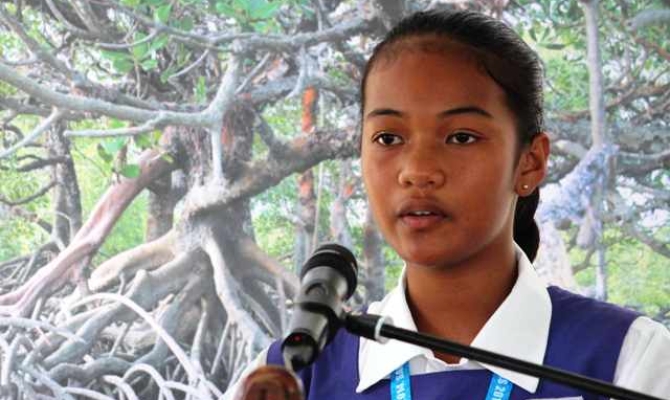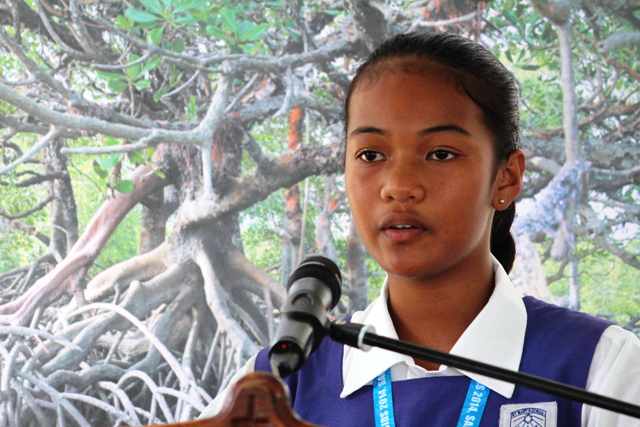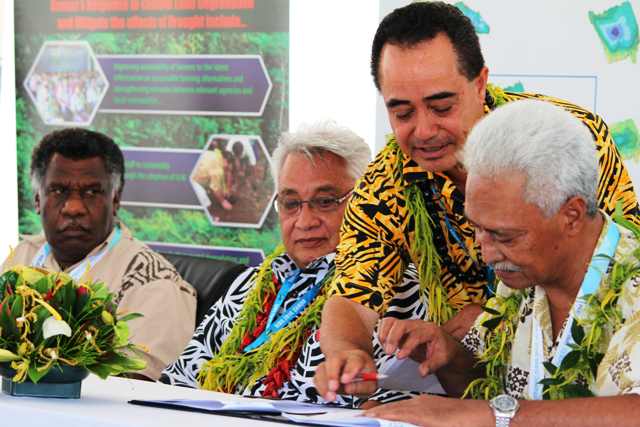
Island and Ocean Ecosystems
By Samisoni Pareti, Group Editor-in-Chief, Islands Business Magazine.
4 September 2014, Apia, Samoa - At the signing of the Pacific Mangrove Charter, the story of children that have turned environmental advocates shone through at the 3rd United Nations Conference on Small Island Developing States which ends in Samoa later today. Experiences of the children were shared - using a tool aimed at enhancing their communities’ resilience to climate change.
Year eight student of St Mary’s School, Delphine Silao and 14-year old Patrick Teo of Loto Taumafai Secondary School, told delegates attending the UN SIDS how their views towards the environment changed drastcall when they participated in a 3 dimensional model project as part of their science class.
Delphine said she and a classmate created a 3D model of the natural resources in her Vaitele village, mapping the forests, rivers and other key features of the village’s ecosystem.
“The project was quite interesting as well as challenging but it helped me to know my village quite better. I now have a deeper appreciate of the need to protect and conserve our forests, our rivers and our traditional knowledge.”
 Delphine Silao, environment advocate
Delphine Silao, environment advocate
Delphine said her 3D model project of Vaitele, an Apia suburb adjacent to the SIDS Village at Tuanaimato, won first prize in her class’ science project contest.
For his 3D model, Patrick said he did a bird-eye view model of his school located in the Apia suburb of Motootua.
“It was a fun activity for me and at the same time a got to learn a lot about protecting the environment I live in. I particularly loved cutting cardboards then colouring them.”
The 3D modelling concept was a German Government funded project of Samoa’s Ministry of Natural Resources and Environment. Hon. Minister Faamoetauloa Lealaiauloto Taito Dr Faale Tumaalii said the 3D model is more than just a mapping exercise.
“It is a living representation of local knowledge and cultural heritage which forms the basis for spatial data interpretation and analysis. The model represents a repository of data, which can be used in future for planning on key development issues. The digitisation of the data visualised on the model offers the opportunity for traditional and scientific knowledge systems to interact on a one-to-one basis,” says Dr Tumaalii.

At the same event, the Minister represented his Government in signing the Pacific Mangrove Charter. Samoa became the first Pacific SIDS to add its support to this agreement, which calls for the protection and conservation of our ecosystem that plays such an important role in the wellbeing and livelihoods of Pacific Island communities.
The Pacific Mangroves Charter is a collective declaration by the leaders of the Pacific Island Countries and Territories with mangroves forests to recognise the importance of mangroves in building our resilience to climate change, the Honourable Minister added.
Joining Samoa in signing the Pacific Mangrove Charter at the 3rd UN SIDS were environment ministers from the Federated States of Micronesia, Republic of the Marshall Islands, Palau, and Vanuatu.
4 September 2014, Apia, Samoa - At the signing of the Pacific Mangrove Charter, the story of children that have turned environmental advocates shone through at the 3rd United Nations Conference on Small Island Developing States which ends in Samoa later today. Experiences of the children were shared - using a tool aimed at enhancing their communities’ resilience to climate change.
Year eight student of St Mary’s School, Delphine Silao and 14-year old Patrick Teo of Loto Taumafai Secondary School, told delegates attending the UN SIDS how their views towards the environment changed drastcall when they participated in a 3 dimensional model project as part of their science class.
Delphine said she and a classmate created a 3D model of the natural resources in her Vaitele village, mapping the forests, rivers and other key features of the village’s ecosystem.
“The project was quite interesting as well as challenging but it helped me to know my village quite better. I now have a deeper appreciate of the need to protect and conserve our forests, our rivers and our traditional knowledge.”
 Delphine Silao, environment advocate
Delphine Silao, environment advocateDelphine said her 3D model project of Vaitele, an Apia suburb adjacent to the SIDS Village at Tuanaimato, won first prize in her class’ science project contest.
For his 3D model, Patrick said he did a bird-eye view model of his school located in the Apia suburb of Motootua.
“It was a fun activity for me and at the same time a got to learn a lot about protecting the environment I live in. I particularly loved cutting cardboards then colouring them.”
The 3D modelling concept was a German Government funded project of Samoa’s Ministry of Natural Resources and Environment. Hon. Minister Faamoetauloa Lealaiauloto Taito Dr Faale Tumaalii said the 3D model is more than just a mapping exercise.
“It is a living representation of local knowledge and cultural heritage which forms the basis for spatial data interpretation and analysis. The model represents a repository of data, which can be used in future for planning on key development issues. The digitisation of the data visualised on the model offers the opportunity for traditional and scientific knowledge systems to interact on a one-to-one basis,” says Dr Tumaalii.

L - R Environment Ministers from Vanuatu, Samoa, FSM signing the Pacific Mangrove Charter
At the same event, the Minister represented his Government in signing the Pacific Mangrove Charter. Samoa became the first Pacific SIDS to add its support to this agreement, which calls for the protection and conservation of our ecosystem that plays such an important role in the wellbeing and livelihoods of Pacific Island communities.
The Pacific Mangroves Charter is a collective declaration by the leaders of the Pacific Island Countries and Territories with mangroves forests to recognise the importance of mangroves in building our resilience to climate change, the Honourable Minister added.
Joining Samoa in signing the Pacific Mangrove Charter at the 3rd UN SIDS were environment ministers from the Federated States of Micronesia, Republic of the Marshall Islands, Palau, and Vanuatu.